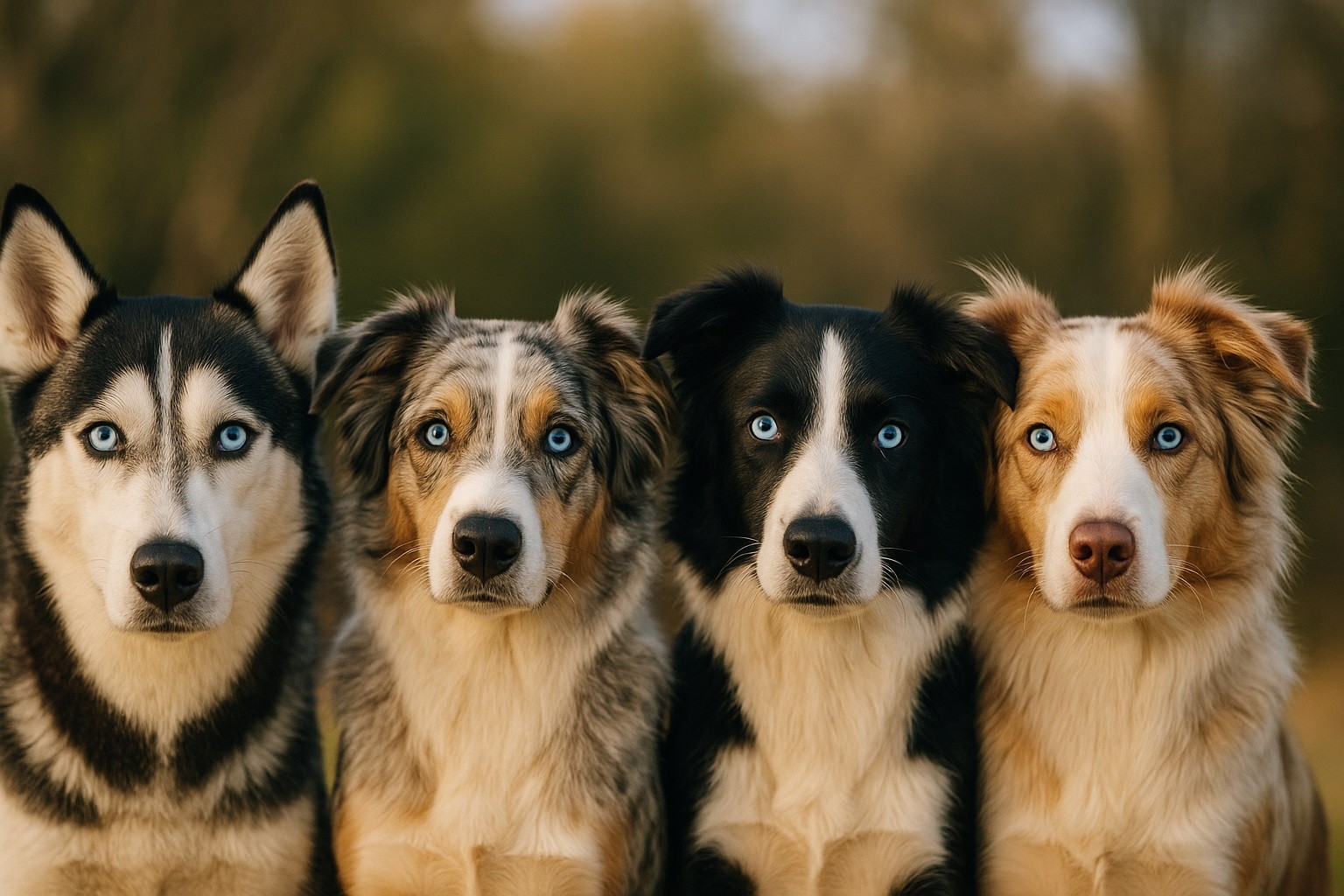Blue eyes in dogs are striking and rare, often making these pets stand out with an almost magical gaze.
While common in humans, blue eyes in dogs are typically tied to specific genetic traits or health conditions.
Dog lovers and breeders alike are fascinated by the mystery behind these icy stares.

The Genetics Behind Blue Eyes in Dogs
Eye color in dogs is primarily determined by genetics. Brown is the most common eye color due to higher melanin levels in the iris.
Blue eyes occur when there is a lack or reduction of melanin, influenced by certain genes or mutations.
One of the most studied genetic causes of blue eyes in dogs is a duplication near the ALX4 gene on chromosome 18.
This mutation is found in many blue-eyed Siberian Huskies and is not associated with coat color, which makes it particularly unique.
In other cases, genes related to coat color indirectly influence eye color:
- Merle gene (PMEL17): Causes a mottled coat and can affect eye pigmentation.
- Piebald gene (MITF): Affects coat pattern and can lead to blue eyes due to a lack of pigment in certain areas.
- White or albino genes: Dogs with little or no pigment in their bodies may have blue eyes due to the absence of melanin.
Dog Breeds Most Likely to Have Blue Eyes
Blue eyes are more common in certain breeds because of the genes prevalent within those breed lines.
In most cases, it’s not just a matter of eye color, but of broader genetic traits.
1. Siberian Husky
One of the few breeds where blue eyes are a standard trait. Huskies can have both eyes blue, one blue and one brown (heterochromia), or parti-colored eyes.
The ALX4 gene mutation is strongly linked to this breed’s blue eyes.
2. Australian Shepherd
Known for the merle coat, Aussies frequently have blue eyes, especially in merle-colored individuals.
However, blue eyes in solid-colored Aussies are rarer and could signal other genetic factors or even visual impairment.
3. Border Collie
Another herding breed that often carries the merle gene, Border Collies may have one or both eyes blue, particularly in merle or lighter-colored individuals.
4. Weimaraner
These dogs often have light amber or blue-gray eyes as puppies. As they grow older, many transition to light amber, but some retain the icy blue gaze.
5. Dachshund (Merle)
Dapple-colored Dachshunds, a type of merle, can inherit blue eyes.
However, responsible breeders monitor merle-to-merle breeding closely due to the increased risk of deafness and eye defects.
6. Great Dane (Harlequin or Merle)
Blue eyes are common in Harlequin or Merle Great Danes. Like other merle breeds, this is often due to pigmentation loss.
7. Pit Bull (American Staffordshire Terrier and American Bully)
Some blue-eyed Pit Bulls exist due to dilute coat colors or the presence of merle or piebald traits.
However, blue eyes in this breed are not officially recognized and may fade as the dog matures.
8. Catahoula Leopard Dog
This breed frequently showcases marbled or glassy blue eyes, especially in dogs with merle coloring.
They often have heterochromia or eyes with mixed pigmentation.
Heterochromia: When Dogs Have Two Different Eye Colors
Heterochromia is a condition in which a dog has two different colored eyes—often one blue and one brown.
It occurs due to variations in melanin distribution and is particularly common in Huskies, Australian Shepherds, and Border Collies.
Though visually unusual, heterochromia is typically harmless unless linked to other genetic disorders or deafness.
Blue Eyes and Health Concerns
While blue eyes can be purely cosmetic, in some cases, they may signal underlying health issues, particularly when caused by certain genetic combinations:
- Merle-to-merle breeding risks: Puppies that inherit two copies of the merle gene (homozygous merle) are at increased risk of blindness and deafness. These dogs often have blue eyes, but the color comes at a cost.
- Albinism or extreme white spotting: Dogs with almost no pigmentation may be more sensitive to sunlight and prone to vision problems.
- Congenital deafness: Often associated with breeds like the Dalmatian or white-coated Bull Terriers, blue eyes may accompany deafness due to shared pigmentation genes.
A blue-eyed dog that suddenly develops cloudy or bluish eyes later in life should be evaluated by a veterinarian.
They must rule out cataracts, glaucoma, or other vision-related conditions.

Are Blue-Eyed Dogs More Prone to Vision Problems?
No, not inherently. In dogs without problematic gene combinations, blue eyes are simply a color variation and do not impair vision.
However, dogs with double merle or severe pigmentation loss (such as those with the piebald or albinism gene) may experience visual impairment.
Veterinary ophthalmologists confirm that blue pigment alone does not reduce light filtering or depth perception.
Thus, most blue-eyed dogs see as well as brown-eyed ones unless other conditions are present.
Are Blue Eyes in Dogs Linked to Behavior?
There is no scientific evidence that links blue eyes to behavioral traits.
However, because blue eyes are more common in working and herding breeds, owners may mistakenly associate the intense gaze with alertness or intelligence.
In reality, behavior is influenced by training, environment, and breed type, not eye color.
Can Blue Eyes Change Over Time?
Yes, puppies are often born with blue or grayish-blue eyes, regardless of their final adult color.
Around 9 to 12 weeks of age, most dogs’ eyes begin changing to their permanent hue.
Only those genetically predisposed will retain true blue eyes into adulthood.
Should You Be Concerned If Your Dog Has Blue Eyes?
In most cases, no. If your dog is from a breed known for blue eyes or has a known merle or piebald background, blue eyes are normal.
However, if you notice sudden changes in eye color or cloudiness, especially in older dogs, consult a veterinarian to rule out eye diseases.
Conclusion: The Beauty and Mystery of Blue-Eyed Dogs
Blue eyes in dogs are a beautiful genetic trait shaped by evolution, selective breeding, and pigmentation science.
From Siberian Huskies to Australian Shepherds, certain breeds carry the genetic keys that unlock this icy-eyed wonder.
While usually harmless, it's important for owners to understand the genetic and health implications tied to these traits.




















